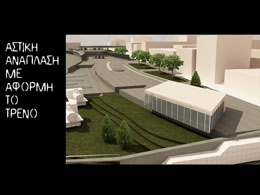STUDENTS PROJECTS
2010

11 March, 2011
Urban reconstruction using the train
Contemporary society is seen more and more as mobility , as transmission of information that continually changes and is translated into constant movement.
Student : Athanasopoulou Antonia
Supervisors: Triantafillidis Giorgos
University of Thessaly
Presentation Date: 12/03/2010
The aspects of flowing and dynamic character are introduced in the architecture.

The study presented here proposes flowing forms, inspired by the existing morphology of the particular space but also by the effort to monitor the mobility of the means and the ideas connected to it. In a railway terminal everything is in motion, the passengers , the employees, the cargo , the train itself. The main expression of this incorporation is the circle, the curve . the ellipse, forms that try to depict and describe motion. The secondary system of design is related to vertical routes that are governed by a periodical rhythm in the designing of the sectional view based on the escape that the city network dictates.
Considering the role that a railway terminal plays in a city , we can confirm the need to constitute a metropolitan centre that can recognize and fulfill the needs of any number of passengers as they change in time. However, a terminal in the concept of an urban gate must be surrounded by a variety of functions but also, by important for public use space. Therefore, we propose a network of pathways , accesses and communal space junctions. This network should provide fast and effortless transportation, connections and optical exits to and from the surrounding urban network as well as, the construction of multi-functional centres as points of reference and social gathering.
This project is situated in the centre of Patras, a focal point in the country for commerce and communication with Italy and the western European countries. It is an urban point of interlocal climax. It deals with the remobilization of an abandoned area in Patras, the old machine-works of the national railway company , OSE.
Today, it is a boundary point in the connection of the coastline to the city,a main entry area to the city. The area of Saint Dionyssios was the starting point of the first electric tram routes in Greece. The remaining railway tracks as well as the old carriages are still in the area of the study. The OSE plans for the modernization of the area of study include an underground way that will go under the existing tracks and the construction of a modern commercial terminal.
The proposed reconstruction of the area, based on the OSE requirements for underground railtracks, places the train activity underground, the entrance to the railway terminal opposite to the port terminal providing a view of the urban space and offering direct access through the main traffic highway. After the plan of the terminal, by moving up to the next level we can find a restaurant and an open area contained by walls which is proposed to facilitate free commerce as well as metal kiosks for short-term housing of sellers. Perpendicular to this area we propose the creation of a unit of overnight accommodation for travelers or visitors. All the constructions are covered by a system of horizontal panels. There is also an open -air square with transparent glass seats and "cracks" in the ground providing abundant natural light in the terminal.
On the other side of this space there is an area with trees as a stop point, a drink-and-snacks shop in the horizontal axis to the temple and a level where the old steam engines are on display. In addition, we propose the construction of an amphitheatre and a corridor covered by an artificial level of water. Our suggestion is to reuse the old carriages for commercial needs as well as, to construct a bridge in the form of an elliptical ramp connecting the area to the port terminal area. Finally, there are a lot of green areas proposed, with greenery and flower beds.
The aim of this proposal is to upgrade the quality of life, to provide specific traffic lines and their allocation in the area and in addition to offer mobile and visual access to the entrance and exit points, using as a tool, a people-centred design with forms that incorporate the modern way of life. These forms interpret movement, transport and transition as image. The proposal also aims to create different settings, the element of wandering and to express the purpose to create a city that relates to its dwellers.






Related articles:
- Urban reconstruction using the train ( 11 March, 2011 )
- Central bus station in the area of Eleonas - Botanikos ( 26 April, 2011 )
- Metro station “KERAMIKOS” ( 29 June, 2012 )
- Gullesfjord Weight Control Station ( 23 October, 2012 )
- Suburban Railway Station. Urban regeneration in Rouf, Athens, Greece ( 21 January, 2013 )
- Interventions on the urban railway stations of the network Patras - Rio ( 13 February, 2013 )
- In.Bu.S, Intercity Bus Station in Chania, Crete ( 02 April, 2013 )
- Railway Station Complex in St. Denis district in Patras, Greece ( 11 April, 2013 )
- Souda Port Passenger Station, Souda Bay,Chania,Crete ( 10 June, 2013 )
- Railscapes: Tracing routes of rail history ( 17 March, 2014 )
- Gorge_ous Trails ( 25 February, 2015 )
- Terminal Station ( 17 April, 2015 )










